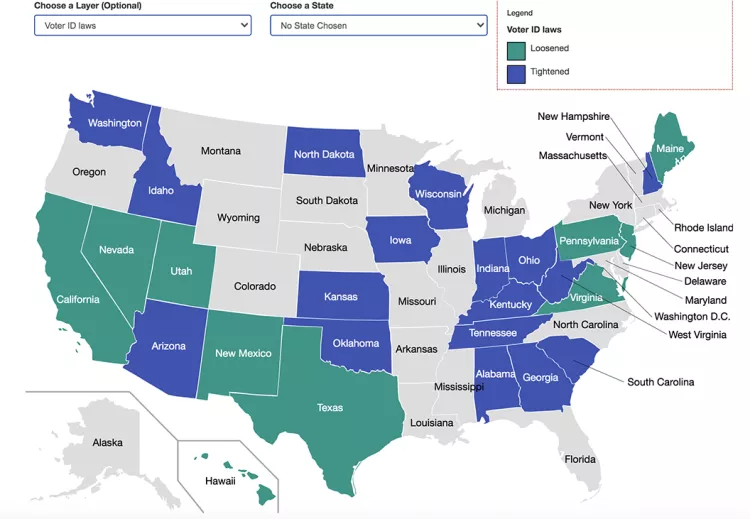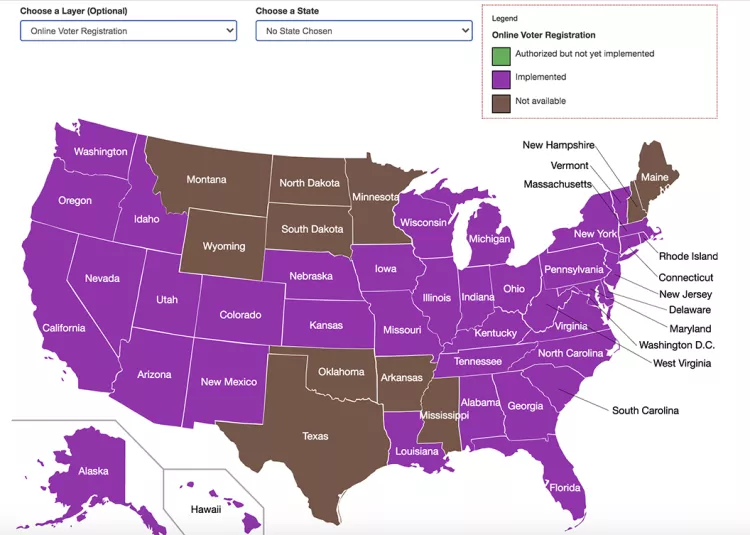With Interactive Map, Students Highlight Changes in Voting Laws

The map compiled by Nackenoff's students allows users to see changes across various categories, including registration rules and procedures, early voting, absentee voting, mail-in balloting, college student voting, voting by convicted felons, voter ID, and more.
View interactive map of voting laws
The 2020 U.S. election has brought a heightened awareness to variations in state voting laws and voter disenfranchisement efforts in some parts the nation. Now, innovative technology and a digital map could help to enlighten the process.
Students in Richter Professor of Political Science Carol Nackenoff’s American Elections class have produced an interactive map highlighting the differences and changes in voting laws over the years in an effort to help the public navigate the various state-level laws from a bird’s-eye view.
“As some states continue to uphold restrictive voting laws, the project showed the importance of making sure voters know the laws in their state and the importance of being vigilant in protecting the right to vote,” says Sam Brody ’24, a student in the class and prospective history major from New York City who researched voting laws in Kansas and New Hampshire.
The map allows users to see changes across various categories, including registration rules and procedures, early voting, absentee voting, mail-in balloting, college student voting, voting by convicted felons, voter ID, and more. In total, users can select from among 18 layers to view the differing state voting laws. A richer picture can be found in the summary page for each state, accessible from the pull-down menu. The data fueling the map was researched and gathered by students in the class.
To mitigate the spread of COVID-19, a number of states made temporary alterations to their voting laws; these are not reflected in this map as they do not reflect permanent changes in voting law.
“The purpose of this mapping exercise is to show students and viewers the kinds of election law changes that states have implemented following the 2002 federal Help America Vote Act,” says Nackenoff, whose American Politics classes produced similar maps in 2012 and 2016.
“While some states have made it easier to vote (even before COVID), many have made it harder. Since 2002, many states have moved to tighten access to the ballot box during this period, especially given the razor-thin margin in the election of 2000.”

In total, users can select from among 18 layers to view the differing state voting laws.
The 2020 edition of the map includes new layers such as “States that Voted Twice for Obama then Trump” and “States that Require Ex-Felons to Make Restitution or Pay Off Court Fees in Order to Vote.”
Using the map, users can see that some states have decreased their early voting access while others have loosened their voter ID requirements. Pennsylvania instituted no-excuse mail-in balloting for the first time in 2020. While the 2016 election saw only five states mail ballots to all registered voters, the 2020 map shows that process has increased to nine. Additionally, there has been a trend to restore voting rights to ex-felons — or at least to those who pay all court fees.
For students, the map provides important context to state voting laws and highlights the unequal access to the voting rights across the nation.
“The patchwork of different laws in different states demonstrate that while federalism provides more independence, it can lead to a messy, decentralized voting process that requires us to place an enormous amount of trust in state and local election officials,” Brody says.



